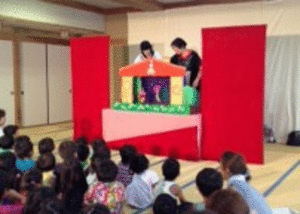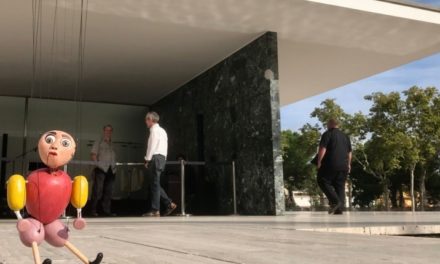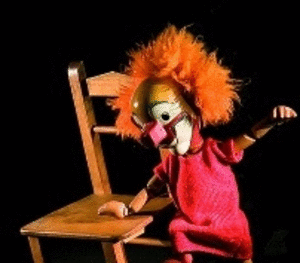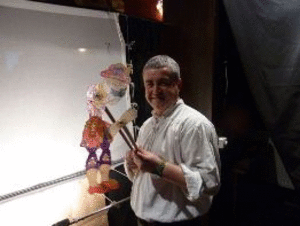Article about the Grand Macabre, by György Ligeti, an opera with a libretto by Ligeti himself and the famous marionettist Michael Meschke, based on an original play by Michel de Ghelderode. Grand Teatre del Liceu, Barcelona.
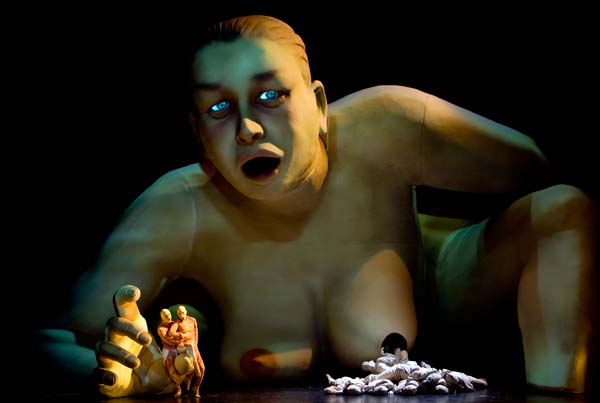
The opera Le Grand Macabre, first performed in Stockholm in April 1978, was presented in a revised version in 1997 in a production by the Fura dels Baus, with stage direction by Àlex Ollé and Valentina Carrasco, and musical direction by Michael Boder.
The reason for an article in Puppetring about this full scale opera is none other than the wish to do justice to a production we consider pure Puppet Theatre in capital letters, and, furthermore, of the most noble kind seen in recent times.
For years now, La Fura dels Baus has regaled us with shows which are fully steeped in so called visual theatre, with a profusion of “plastic” or sculptural elements and a preponderance of images created with supreme care.
Besides the imagination of their directors (Àlex Ollé and Carles Padrissa), the Fura works with a number of close collaborators who approach the image from different perspectives and are highly regarded in their own fields. Roland Olbeeter comes to mind, the scenographer and member of the company responsible for coming up with their most original and sophisticated machinery and gadgets, (among other things he is a nautical engineer). In 2005, Roland’s Orlando Furioso! was presented in the Pocket Opera Festival in Barcelona. In this piece five acoustic, mechanical instruments played themselves, as they moved around the space like robotic puppets, interacting with the singer Claudia Schneider. Or, equally, the video-artist Franc Aleu, an indispensable presence in most of the Fura’s productions; or the various scenographers who have worked with the company.
In the Le Grand Macabre, the “Fureros” (with a set designed by Alfons Flores) hit the bull’s eye when they came up with the idea of a gigantic puppet which occupies the whole opera theatre’s stage and which centres the action and draws it together.
A puppet, because it has articulated parts (mouth, eyes, head and legs, as well as the body’s natural orifices which open and close as required), because it can turn, and, above all, because it comes to life as a character, thanks in part to the use of video projection which gives it a face with facial movements and multiple body textures, and because at a certain moment we perceive it as its own skeleton, thanks to the translucent nature of the doll’s skin which allows the bones of the inner structure to be seen.
If a production achieves a completely organic relationship between a central element of the set and the other elements of the performance, it can be said that the “dramaturgical bullseye” has been hit; this is something that is extremely difficult to achieve. When it’s succesful, the miracle happens and the show will fly, to the full extent of its potential. This is what happened with the Fura’s version of Le Grand Macabre.
In its day, (the work was premiered as has been said in 1978), Michael Meshke, the illustrious marionette puppeteer, participated in writing the libretto of Le Grand Macabre. This is apparent in the buffonesque style, almost “ubuesque”, of the text, with language which is reminiscent of Jarry’s. Meshke directed Alfred Jarry’s Ubu Roi in 1965, in a production that has entered the anthologies which continued to be performed until 1990, which indicates the importance this work had on the world of the Polish puppeteer. Who is the character, really, of Nekrotzar (Death in Ligeti’s opera) if not a kind of ridiculous and capricious Ubu, laughed at by his own assistants and who, furthermore, at the end discovers he’s afraid of his ex-wife? An Ubu who kills everything he touches but who, at the same time is ridiculous and grotesque, as are all the powerful characters who appear in the work.
All the characters emerge out of the huge doll at the centre of the opera, (modelled on the naked body of Claudia Schneider, who appears in a video at the beginning and end of the production): some from the mouth, others from the eyes or from the vagina, and when the figure is turned round, the buttocks are parted and another space is created which contains the intestines and which, once these have been extracted, even becomes a kind of disco-bar where a party’s going on.
Each scene and each act is marked by the doll’s new position, its movements, and the way the spaces inside, around, or on it are used, in such a way that it can be claimed that it absolutely centres the action and the production itself.
For anyone interested in this prodigious production and some of the comments it has earned, I invite you to visit the Fura’s web page, where you can see images, texts and video, as well as reviews and comments.
Translation – Rebecca Simpson



